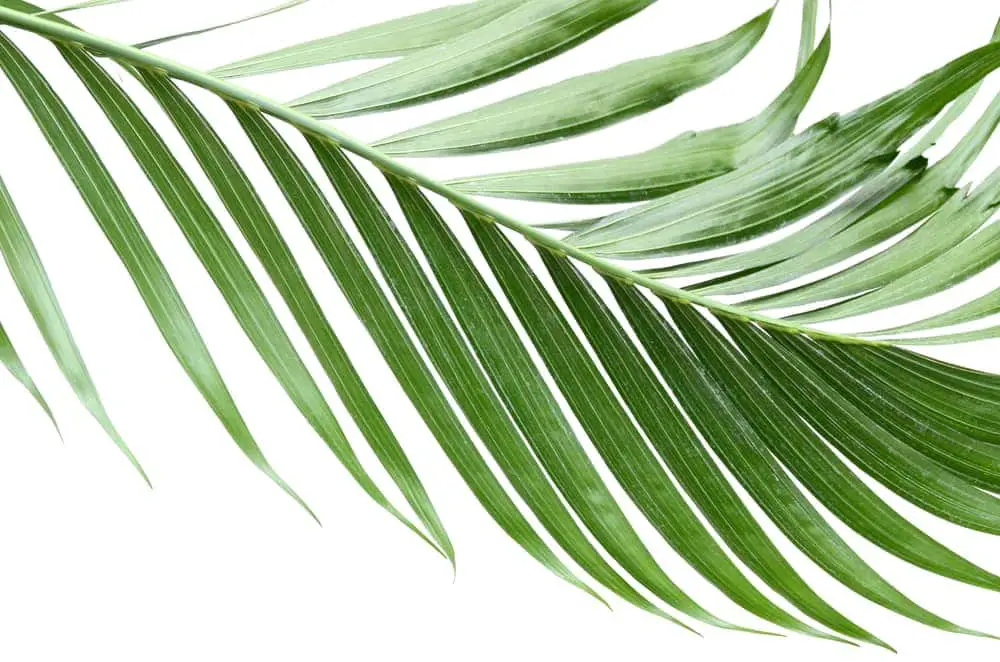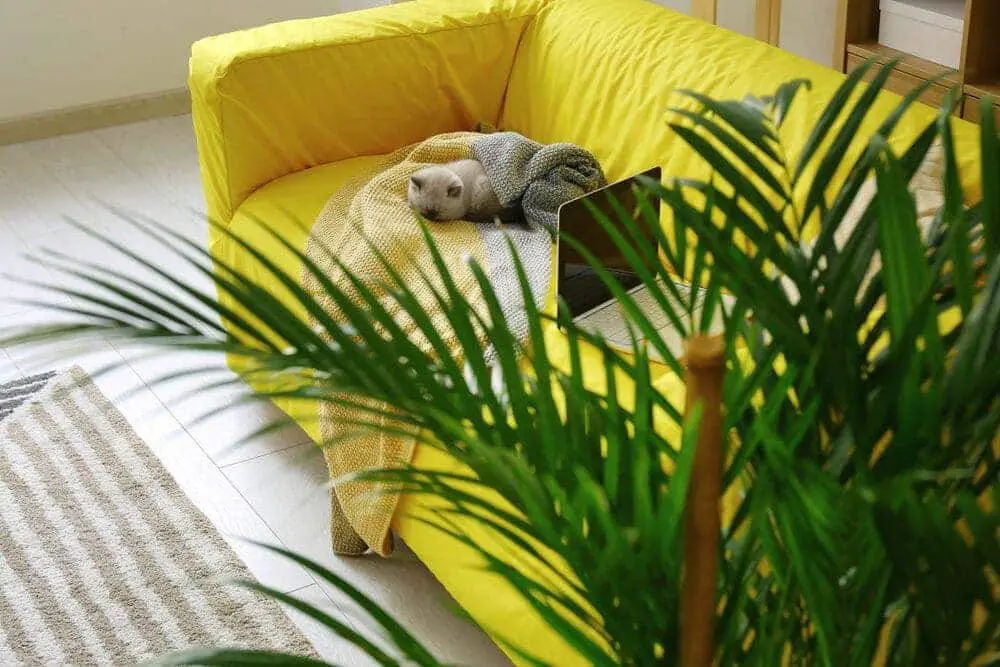The Cat Palm is native to southeastern Mexico. It is also known as a Mexican Hat palm.
It is a trunkless palm tree. This is a plant that requires a very tropical environment but still many love to try to grow it as an indoor plant.
Cat Palm Care & Growing Guide
1. Light Requirement
The Cat Palm does not need direct sunlight but prefers bright, indirect light. Each week, you should turn your planter a quarter turn so that all sides are exposed to some light sunlight during the morning. In the summer, make sure that you are keeping your Cat Palm shaded from the hot midday sun.
2. Water
With the Cat Palm, you need to keep the soil moist but not soggy. Your Cat Palm should be kept lightly moist all year. The planter should have drain holes so the excess water can drain out. When you water your indoor Cat Palm, water until you see the water starting to come out the drain holes, which indicates it has had enough water.
Always make sure that you are using tepid water because using cold water can shock them. Because tap water can contain chemicals you should use rainwater or distilled water.
3. Climate
USDA Hardiness Zone 9-11
4. Soil
The soil needs to be quick draining and not heavy or clay-like. If it is, you can add some sand or peat moss to the soil. One mixture you can use is three parts of African violet mix potting soil with one part sand.
The less fertilizer you feed your Cat Palm, the better, but you should feed it monthly in the spring and summer. You should use a fertilizer that is balanced but diluted to one-half of the recommended strength. During the fall and winter, they will only need to be fertilized one or two times.

5. Temperature
Although the Cat Palm likes the warmth, they do not like too much dry heat as it can cause leaf damage. The ideal temperature would be 70-80 degrees Fahrenheit during the daytime and at night, the temperatures should not be below 45 degrees Fahrenheit. Make sure that the Cat Palm is not sitting near heaters, in drafty areas, or near air conditions. They will suffer if they get cold.
The room where they are should have about 55% humidity. To make sure that your Cat Palm has the right humidity, you can place the planter on a tray of wet gravel. The planter has to sit on the gravel but not in the water on the tray. You could also use a humidifier in the room.
6. Repotting
You will not have to repot your Cat Palm until the roots have filled the pot it is in because they like to be root bound.
7. Speed of Growth
When grown indoors, it is a very slow-growing plant.
8. Height and Spread
The mature height of the Cat Palm is four to six feet with leaves that can grow to one foot long and one inch wide.
9. Flowers
The Cat Palm does not produce flowers but does produce fronds that can have 30-50 leaflets. They have pinnate leaves with green, slender, cane-like leaf stems.
10. Trimming
To trim a Cat Palm, you will need to cut off any brown or yellow fronds quickly using a pair of wet scissors. Doing this should help to prevent any more brown or yellow fronds.

Is Cat Palm Poisonous?
Cat Palm’s are non-toxic to animals and humans.
Can Cat Palm Grow in Water?
No, they cannot grow in water but must be grown in soil.
How to get Cat Palm to Flower?
They do not have flowers.
Common Cat Palm Plant Diseases
Cat Palm is prone to a variety of diseases, including:
- Leaf tip burns—this occurs when the water contains chemicals like fluoride or the water is salty. Use filtered water or rainwater to help prevent this.
- Yellow fronds—the soil is too dry so you need to give your plant some water.
- Brown fronds—this is caused by overwatering.
- Spider Mites—the Cat Palm is highly susceptible to this type of insect and if there is a bad infestation, the plant can die. If you see these little insects, you can use a hose to forcibly to wash them off. Continue to mist your plants daily to prevent them from coming back.
- Mealy Bugs—these can cause your fronds to turn yellow and then brown. The mealybugs will suck the juice from the plant. Use a mixture of half and half water and isopropyl alcohol to spray the leaves to get rid of them.
- Brown, elliptical spots on the leaflets—this could be a sign of copper toxicity. This generally happens if you use fungicides that contain copper so you need to check your fungicide to see if it has copper. If so, change fungicides to get rid of the problem.
More like this: Pachypodium (Madagascar Palm) Care & Growing Guide
Conclusion
- You should wipe off the palm fronds occasionally with a damp cloth as they often get dusty.
- They have a unique, clustering trunk that can be slightly horizontal, forked, or clumping. The trunks are only an inch in diameter with the leaflets being 12 inches long.
- They are a fluffy palm that is often used in a short, dense screen, accent, or backdrop.
- The bloom stalks are either female or male. After releasing their pollen the male stalks will wither and if the female stalks are pollinated, they will turn bright orange. This is how they sexually reproduce from seeds or asexually when new plants sprout from the base of older plants.
- When grown indoors, it can be used as a type of plant to divide living areas or defining entryways.
- They are grown for their beautiful foliage.
- It is considered a clean air plant as it will help to remove carbon monoxide and formaldehyde from the air.
- In warmer climates where it can be grown outdoors year-round, it will be used as a hedge plant.

Victoria is the owner and main author of hobby plants. She loves spending her free time in her garden planting and taking care of her plants. Victoria hopes you enjoy the content here!

![Majesty Palm Plant Care: [Complete Beginner's Guide] Majesty Palm Plant Care: [Complete Beginner's Guide]](https://www.hobbyplants.com/wp-content/uploads/2022/08/majesty-palm-care-300x158.jpg)
![Why Does My Majesty Palm Have Brown Tips? [EXPLAINED] Why Does My Majesty Palm Have Brown Tips? [EXPLAINED]](https://www.hobbyplants.com/wp-content/uploads/2022/08/majesty-palm-brown-tips-300x158.jpg)
![What Causes Brown Tips on A Ponytail Palm? [EXPLAINED] What Causes Brown Tips on A Ponytail Palm? [EXPLAINED]](https://www.hobbyplants.com/wp-content/uploads/2022/08/brown-tips-on-ponytail-palm-300x158.jpg)
![Mother Of Thousands Plant [Complete Plant Care Guide] Mother Of Thousands Plant [Complete Plant Care Guide]](https://www.hobbyplants.com/wp-content/uploads/2022/07/mother-of-thousands-plant-300x158.jpg)
![How Often Should You Water Pothos? [Complete Care Guide] How Often Should You Water Pothos? [Complete Care Guide]](https://www.hobbyplants.com/wp-content/uploads/2022/07/how-often-to-water-pothos-300x158.jpg)
![Can Snake Plants Live Outside? [COMPLETE CARE GUIDE] Can Snake Plants Live Outside? [COMPLETE CARE GUIDE]](https://www.hobbyplants.com/wp-content/uploads/2022/08/can-snake-plants-live-outside-300x158.jpg)
![Exotic Angel Plant Care: [Complete Beginner's Guide] Exotic Angel Plant Care: [Complete Beginner's Guide]](https://www.hobbyplants.com/wp-content/uploads/2022/08/exotic-angel-plant-care-300x158.jpg)
![Do Coleus Like Sun Or Shade: [Complete Care Guide] Do Coleus Like Sun Or Shade: [Complete Care Guide]](https://www.hobbyplants.com/wp-content/uploads/2022/08/coleus-sun-or-shade-300x158.jpg)
![Snow White Waffle Plant: [Complete Care Guide] Snow White Waffle Plant: [Complete Care Guide]](https://www.hobbyplants.com/wp-content/uploads/2022/08/snow-white-waffle-plant-300x158.jpg)
![Waffle Plant Care: [Complete Beginner's Guide] Waffle Plant Care: [Complete Beginner's Guide]](https://www.hobbyplants.com/wp-content/uploads/2022/08/waffle-plant-300x158.jpg)
![Bird Of Paradise Plant Care: [Complete Beginner's Guide] Bird Of Paradise Plant Care: [Complete Beginner's Guide]](https://www.hobbyplants.com/wp-content/uploads/2022/08/bird-of-paradise-plant-300x158.jpg)